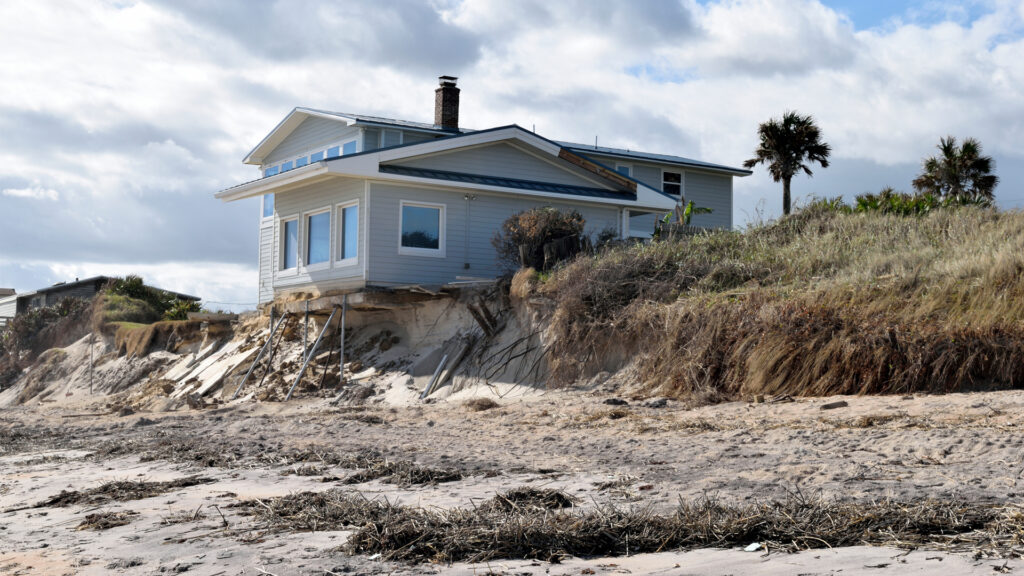By Rob Young and Katie Peek, Program for the Study of Developed Shorelines
On the heels of Hurricane Ian, the Florida Legislature this year passed the Hurricane Restoration Reimbursement Grant Program. The program allocates $50 million to reimburse oceanfront property owners for the construction of seawalls in the name of coastal protection. Any beachfront parcel owner may apply for $150,000 with a 50/50 percent homeowner match to construct seawalls that protect private property.

It is hard to imagine a more wrong-headed and maladaptive coastal management policy. The worst way to manage the coast is one parcel at a time. The only way to make it worse is to drive that piecemeal seawall construction with public funding.
Make no mistake, the seawall grant program will harm Florida beaches and result in a patchwork of coastal hardening projects that will end with neighbors in litigation as new walls push storm impacts onto adjacent properties.
Every action taken on the oceanfront will impact your neighbors. Seawalls have clear, well-documented negative impacts on beaches, dunes and neighboring property owners. Unfortunately, with the seawall grant program, the Florida Legislature and the Florida Department of Environmental Protection have pushed Florida coastal management back to the 1960s and possibly pitted neighbor against neighbor.
There is clear, scientific consensus that seawalls — or any shore-parallel hard structure designed to halt erosion — when placed on an eroding or retreating beach will cause that beach to narrow and eventually disappear. The negative effects of seawalls on beaches are so clear that they have been included in textbooks and have been the subject of numerous scientific articles over the past 50 years.
In a 1981 technical note, the U.S. Army Corps of Engineers recognized the problems with seawalls. The report states that seawalls protect only the land immediately behind them, offering no protection to fronting beaches. Also on a receding shoreline, recession of the beach will continue and may even be accelerated by the construction of a seawall. If nearby beaches were being supplied with sand by the erosion of the area protected by a new seawall, the beaches will be starved and will experience increased erosion.
The Army Corps of Engineers tacitly admits that seawalls will cause the eventual disappearance of the beach in front of the wall and increase erosion and storm impacts on adjacent properties. If there are several walls in a row, the first property without a wall will be in big trouble. Soon, everyone builds a wall.
The negative impacts of seawalls are so well understood that several states have banned the construction of new walls since the 1980s. North Carolina legislation outright prohibits seawalls, stating directly that: Permanent erosion control structures may cause significant adverse impacts on the value and enjoyment of adjacent properties or public access to and use of the ocean beach, and, therefore, are prohibited. Such structures include bulkheads, seawalls, revetments, jetties, groins and breakwaters.
We assure you, North Carolina has not banned seawalls to save turtles or birds. The goal is to preserve public beach access and the heart of the coastal economy — the dry, sandy beach. North Carolina’s legislative ban also prevents situations that find neighbors coming to blows over the harm a new wall can cause during a storm.

Finally, it is important to note that the same process operates not just on the Atlantic and Gulf coasts of Florida but within Tampa Bay itself. Bulkheads and other walls will eliminate any beach or wetland over time as sea level rises and the shoreline attempts to move landward.
Banning seawalls isn’t just good coastal management; it maintains peace in oceanfront communities reeling after severe weather events.
Our hearts break to see Florida going down this road. Beaches will degrade. The public and tourists will lose public beach access. And, though oceanfront property owners will still have a view, folks off the beach will have no beachfront to use, all while watching their property values decline.

Please explain how it is in the interest of all Floridians to help pay the cost of protecting what are largely investment properties anyway.
The Florida Administrative Code requires that any armoring shall not result in the loss of public beach access along the beach. We have seen no analysis of how the state’s new seawall grant program addresses this requirement to ensure that Floridians and tourists retain the right to walk along the beach.
Based upon what we know about seawalls, the Hurricane Restoration Reimbursement Grant Program seriously threatens that right and our beachfront economies.
Rob Young is director and Katie Peek is a research scientist at the Program for the Study of Developed Shorelines at Western Carolina University.
This opinion piece was originally published by the Tampa Bay Times, which is a media partner of The Invading Sea.
If you are interested in submitting an opinion piece to The Invading Sea, email Editor Nathan Crabbe at ncrabbe@fau.edu. Sign up for The Invading Sea newsletter by visiting here.



